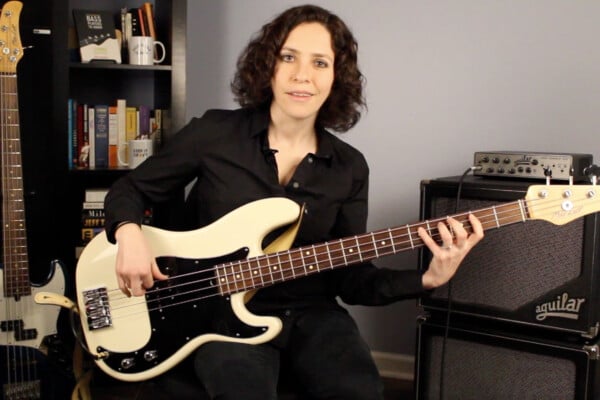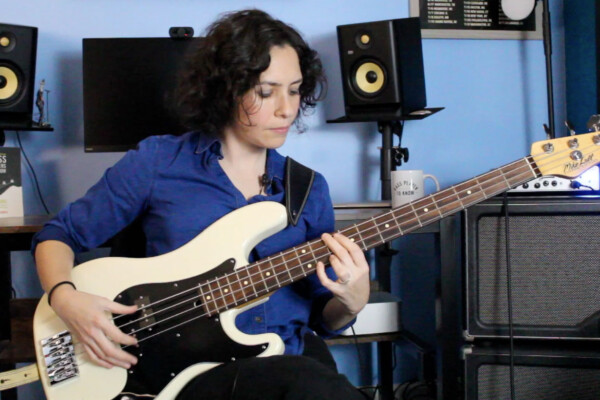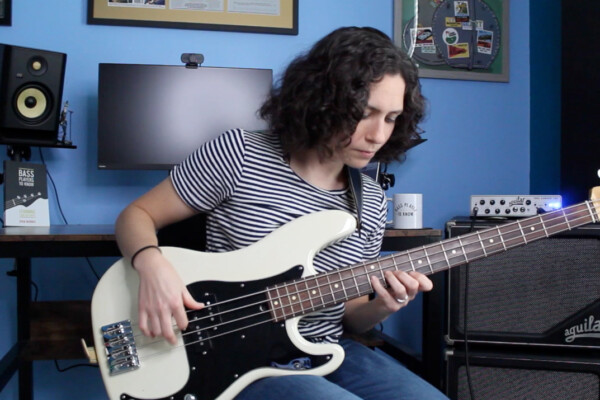Melodic Minor vs. Diminished Scales Over Dominant Chords
Q: You know, jazz theory can be really, really confusing! I know that you can use a melodic minor a half step above a dominant chord as a substitution before resolving to the I-chord to emphasize tension notes (creating an out-sound). But, apparently, you can also use a whole-half diminished scale a half step up from the same dominant chord. These two scales share many notes, except for a few. For example, if I understand it correctly, an A? melodic minor (played over a G7) contains an E?, while the A? whole-half diminished scale does not contain an E?, but rather an E and a D. Can you say something about how this makes sense? Alternatively, can you give an example of how to approach in using either one or the other?
A: This stuff threw me for a loop for years and can be very confusing, partially due to the vernacular. I’ll try as hard as I can to use plain English here and not make things sound more confusing than they are. It sounds like you have a good handle on the foundations of harmony, but I would caution students just getting going with jazz harmony against banging your head against the wall too hard until you’ve really gotten the fundamentals under your fingers and in your mind. Don’t worry if you don’t quite understand everything here. Maybe you’ll pick a little something up, or maybe you’ll reference it in years to come and finally understand what fun the world we’re talking about.
The shortest answer is this: Much of what makes either choice work is how well your line resolves. It’s all about context and the resolution of tension. There are a few different ways to treat altered dominant chords (note: an altered dominant chord is any Dominant chord with an alteration of any kind. (C7?9, C7?11, C7?5, C7alt, etc. – all of those are technically altered dominants). There are so many different ways to play over an altered chord that ultimately all of the notes are available to you. What makes them work or not is the context you give your line and how well it resolves. By context, I mean that the notes have a relationship to one another – not random play any of the notes because they all work, but rather, you used the notes from a scale or combination of scales and made a melodic statement with them.
Because either of those scales mentioned take a while to internalize, many players will focus on one over the other for a time and then explore alternate scalar options. Ultimately, one would likely choose which scale to use based on two things:
- The spelling of the chord. What kind of alterations does it have as it’s written?
- The sound you want to make. Do I want a diminished type of sound, altered scale sound, whole tone sound, etc.
Let me speak about those two scales in particular, although there are other options as well which you would use depending on the spelling of the chord.
To read a little more about some of the other options, check this column.
So here are those two scales you mentioned starting on a B:
Super Locrian (7th mode melodic minor, also called the altered scale)
B | C | D | D? | F | G | A
R | ?9 | ?9 | 3 | ?5(?11) | ?13 | ?7
Half/whole diminished scale (Octatonic)
B | C | D | D? | F | F? | G? | A
R | ?9 | ?9 | 3 | ?11 | 5 | 13 | ?7
These two scales have two notes that don’t align. That’s ok, don’t worry about that. Like I said, it’s more about how you apply the line and which chord spelling you want to outline and what sound you want to play.
In the “altered scale,” every extension (non-chord tone) is altered. You have the ?9, ?9, ?11 and ?13. You also don’t have any natural fifth, so even one of the primary chord tones is altered.
I tend to use this scale when the chord is actually written as an “alt” chord (B7alt). That spelling leaves the voicing up to the chordal instrumentalist and, unless I hear that their voicing isn’t working with this scale, I’ll assume that everything is altered.
The half/whole scale became popular with a lot of instrumentalists because:
- It has a very distinctive sound
- It is a symmetrical scale and, therefore, works over more than one chord. The same spelling works for altered chords spread in minor 3rds.
In other words, B7alt would use the same notes as D7alt, F7alt and Ab7alt (or G?, if you look at the scalar spelling above). That’s four altered chords (out of a possible 12) for the price of one scale under your fingers!
Now, remember that I mentioned that you would use the whole/half scale over diminished chords?
If you start the half/whole scale on the 2nd degree, you get a whole/half, by default. This means that the one scale I spelled above works for these eight chords:
B7alt, D7alt, F7alt, A?7alt, AND Cdim7, Ebdim7, F?dim7, Adim7
If you do the math, you only have to learn and internalize that one scale in B, C and C? and you can play over every single possible altered OR diminished chord!
This is why the scale became quite popular among many improvising jazz soloists, especially those who play a nonsymmetrical instrument. On bass, each scale has the same shape because we are usually strung up in a straight 4th tuning. Brass, reeds, pianos – they all have different fingerings for each scale. If you can learn three scales and cover 24 different chords, that’s likely to become a focus at some point in your development and quite the handy tool.
I got relatively comfortable with the half/whole scale and found myself thinking in that scale over diminished chords as well. I would just move down a half step and pretend my diminished chord was an altered chord.
In other words, if I saw a Cdim7, I would just pretend it was a B7alt and play what I would normally play. It worked for me, but I don’t tend to use that scale a whole bunch, anyway, so my little cheat never became too big a deal, and I never bothered to more fully invest myself in the study and internalization of those scales beyond that.
I perceived the scale as something a little different. I saw it as a dominant chord, with a ?9 and chromatic approach notes leading to every primary chord tone. For example:
- Root
- ?9
- Chromatic approach to the 3
- Chromatic approach to the 5
- Chromatic approach to the ?7
I have developed a preference for a number of different scales depending on the spelling of the chord. I only ever think altered scale unless I see “alt” actually written. I only ever think diminished when I think that the sound could work well in the scope of my line, and I am just as likely to use it on another chord type as I am an altered or diminished chord. The beauty of the diminished scale (half/whole or whole/half) is that it has such a distinctive sound that, as long as you resolve it well, it can kind of work over anything. It stands on it’s own (as long as you resolve it well. That is the key, and I can’t say enough about that. You need to turn that scale or diminished lick into something inside the harmony. Whether it’s the last note of the run or you morph into a different tonality, it needs to land squarely inside the music).
If you reference that link at the beginning of the column, you will notice quite a few scales listed for different types of altered dominant chords. In actuality, I probably use the altered scale and the diminished scale the least of any options, and if I am thinking of the altered scale, I’m actually playing a different mode from the melodic minor scale over a different root. Same notes, but I’ll move down a 3rd and play the 5th mode of melodic minor. This makes the root of my altered chord, the 3rd of my Mixolydian ?6 scale. For example: If I see a C7alt, I’ll likely play A? Mixolydian ?6. This is primarily because the scale fits under my fingers better, and I’m lazy but also has the side benefit of getting me away from the root in my mind. This is covered more fully in my 3-part series on harmonic substitutions:
I hope that helps a little bit. Everybody sees this stuff a little differently and internalizes it a little differently. I suggest that you explore it all and find what works for you. Don’t use a scale because I or some jazz text book said that you should. If you like the sound of “X” over “Y” chord, then use it. We all hear things a little differently, and I didn’t like the sound of much of this stuff for quite a few years until my hearing evolved a little bit. The more I heard it and explored it, the better it sounded and the more it made sense. Just be patient and have fun with it.
The key is practicing it with intention and not letting yourself noodle away at random over the chords you don’t understand. It sounds like you are doing the work and exploring it with thoughtful intention. Keep up the great work!
Have a question for Damian Erskine? Send it to [email protected]. Check out Damian’s instructional books, Right Hand Drive and The Improviser’s Path.



